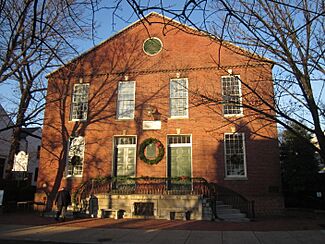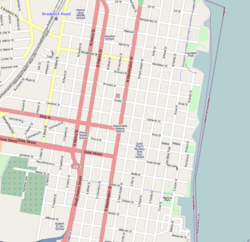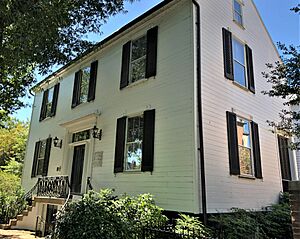Old Presbyterian Meeting House facts for kids
|
Old Presbyterian Meeting House
|
|

Front facade (2011)
|
|
| Location | 321 S. Fairfax St., Alexandria, Virginia |
|---|---|
| Area | 0.5 acres (0.20 ha) |
| Built | 1775, rebuilt 1836 |
| Architectural style | Early Republic |
| NRHP reference No. | 01000143 |
Quick facts for kids Significant dates |
|
| Added to NRHP | February 16, 2001 |
The Old Presbyterian Meeting House is a historic Christian church. You can find it at 321 South Fairfax Street in the Old Town area of Alexandria, Virginia. It belongs to the Presbyterian Church (USA).
This meeting house was first built in 1775. It was designed in the Early Republic style. Sadly, a fire badly damaged it in 1835. The church was rebuilt in 1836. A bell tower was added in 1843, and granite stairs were put in place in 1853. The church property was added to the National Register of Historic Places in 2001. This means it is a very important historical site.
Contents
History of the Meeting House
The story of the Old Presbyterian Meeting House began in the early 1700s. Many Scottish Presbyterians were among the first European settlers in Northern Virginia. They helped create Alexandria as a port city in 1749. The group of Presbyterians started worshiping publicly in the 1760s. Their first minister arrived in 1772. The Meeting House itself was built in 1775.
Rebuilding After the Fire
After the big fire in 1835, the church was rebuilt. It kept its simple, plain style. A bell tower was added in 1843. New granite stairs were put in place in 1853. The building looks much the same today.
George Washington's Connection
Many important events happened at the Meeting House. George Washington attended services here. One special service was for a "National Day of Solemn Humiliation, Fasting, and Prayer" in 1798. After Washington passed away in 1799, his memorial services in Alexandria were held here. The church bell rang for four days to show sadness.
The Church Through the Civil War
The Meeting House stayed open during the Civil War. However, fewer people attended services afterward. In 1899, the building closed for worship. Another church, Second Presbyterian Church, took care of the property. For the next 50 years, it was a museum and sometimes a place of worship. In 1949, a new church group formed there. They called themselves "the Old Presbyterian Meeting House."
Music and Organs
Music has always been a big part of the Meeting House. It has hosted public concerts for over 200 years. Its first pipe organ was installed in 1817. This was the first pipe organ in a Presbyterian church in the United States. That organ was lost in the 1835 fire. The organ in the front of the church is from 1849. A newer organ was added in 1997.
Church Grounds and Buildings
Next to the Meeting House are a Burial Ground and several other buildings. The Flounder House, built in 1787, was once a home for the minister. The Elliot House (1844) was a private home. The Education Building was built in 1957.
The Burial Ground
The Burial Ground is a special cemetery. Many heroes from the Revolutionary War are buried here. One unknown soldier is honored with the Tomb of the Unknown Soldier of the American Revolution. More than 300 people are buried here. These include John Carlyle, who helped start Alexandria. Also buried here is Dr. James Craik, a doctor for George Washington's army.
Presbyterian Cemetery
The Meeting House also takes care of the Presbyterian Cemetery. This cemetery is about a mile west of the church. It opened in 1809. Many important people are buried there. These include 17 Revolutionary War heroes. Soldiers from the War of 1812 and the Civil War are also buried there. Many mayors, business leaders, and even a member of the U.S. House of Representatives rest here. In 2008, a columbarium was added for ashes.
The Congregation Today
Today, the Old Presbyterian Meeting House is a busy church. It is led by Reverend Dr. Robert R. Laha, Jr., and two other pastors. A group of 26 elders helps guide the church. More than 1,000 members belong to this church. They welcome everyone for worship, learning, and helping others. The church has programs for all ages, from young children to older adults.
Music and Community
Music is very important in worship services. The church uses its pipe organs and has a choir. Sometimes, special services feature brass groups or children's choirs. The church also hosts "Concerts With A Cause." These concerts feature local artists. Money collected at these events helps local charities. During the Advent season, there are "Noonday Noels" with music and readings.
Helping Others
The Meeting House is very active in helping people. It supports many local, national, and global programs. For example, it helps with tutoring for kids. It also helps families pay their bills. The church works to improve homes for people in need. It supports groups that help the poor and protect the environment.
The church also does mission projects in other places. They have partnerships in Mexico, Pakistan, Haiti, and Kenya. They also work to make sure everyone has affordable housing and good health care. In 2011, the church started a program to help families visit loved ones in distant prisons using video calls.
Using the Buildings
The Flounder House now has classrooms and meeting spaces. It also holds the church's old records. The Elliot House is where the church offices are located. The Education Building has classrooms and a large meeting room. It also houses the Meeting House pre-school.
The burial ground on the church property is no longer used for new burials. However, the Presbyterian Cemetery is still active. It has been used for over 200 years.
See also




